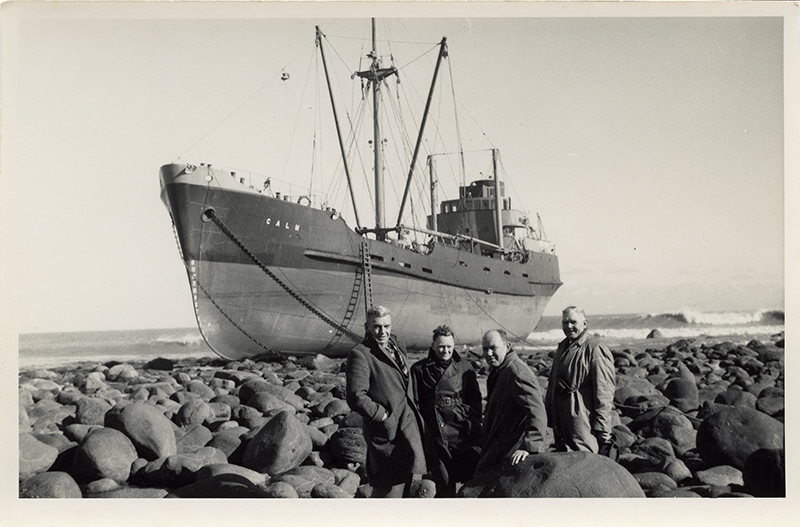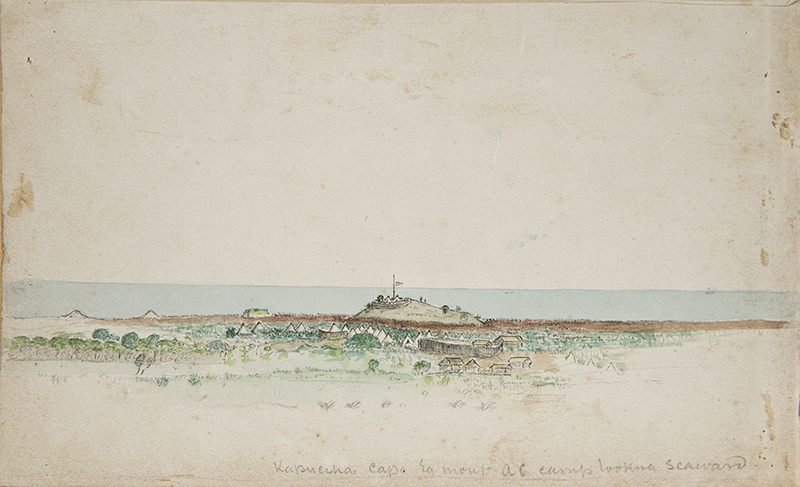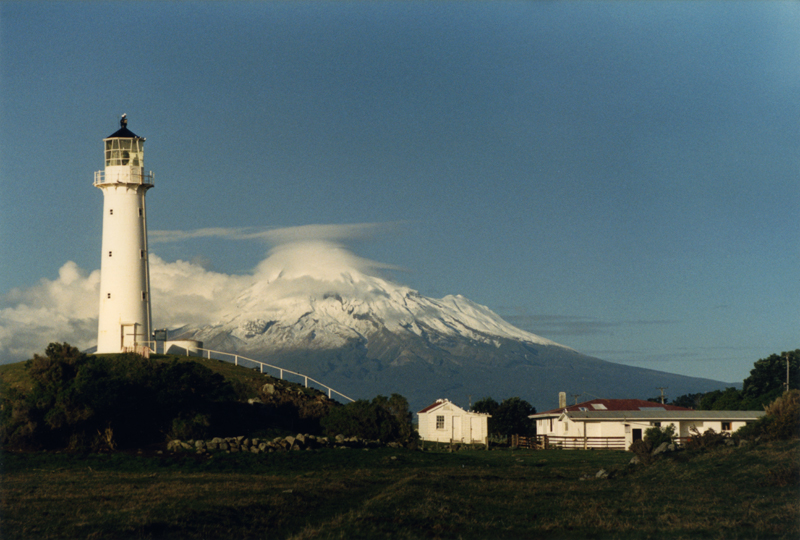



A fairy-tale figure with a wizard-like beard is the last keeper of the Cape Egmont Lighthouse. But these days, Bryan Richards is the keeper of the tower's story, not its light. The Welshman's skills became redundant in 1986 when he was replaced by an automatic light. He was 55. Instead of moving on from the navigational lifesaver, Bryan (aged 72 when interview in 2003) and his wife Janet (aged 65 when interview in 2003) retired on the land beneath the soaring structure.
By day, the tower punctuates Taranaki's western-most point like an exclamation mark. By night, it flashes white light once every eight seconds, telling ships up to 19 nautical miles away that they are nearing a latitude of 39 degrees, 16.6 minutes south, and a longitude of 173 degrees, 45.2 minutes east.
From the Richards' humble home, the tower is framed in the dining room window, an ever-looming reminder of the past.
The lighthouse was built in Pimlico, London, in the mid-1800s. In 1865, the cast-iron segments were shipped to New Zealand and assembled on Mana Island, north of Wellington. However, the spot proved unsatisfactory. "The Mana Island Station was closed in 1877 following several shipping accidents as it was believed this light was being confused with the Pencarrow Light at Wellington Heads" Bryan says. "In 1881, the tower was dismantled and carried in sections by the Government steamer, Hinemoa, to Cape Egmont and reassembled on its site."
Bryan says the huge, heavy lighthouse pieces would have been brought to shore by surfboats, manned by skilled oarsmen. It is likely bullock teams would have been used to drag the segments into position, where they were bolted together. Although the tower was in the best position for maritime navigation, its on-land placement came with problems.
Just a few miles away was the settlement of Parihaka, which at the time was the centre of a Māori non-violent movement led by Te Whiti-o-Rongomai and Tohu Kākahi. Using passive, but effective resistance, the people of Parihaka managed to delay the erection of the lighthouse. In reply, the colonial authorities stationed about 40 members of the Armed Constabulary at the tower to ensure its completion, and the light finally shone on 1 August 1881.
Even though their job was done, the constabulary continued living on the first floor of the building, preparing for the historic raid on Parihaka. Correspondence shows the first keepers of the then two-man station were more upset by the military guests than a possible Māori attack. This was conveyed in a letter to the Marine Department in Wellington written by Cape Egmont's principal keeper, Mr Simpson. It said he was indignant about having to knock on his own lighthouse door to be let in and it was only opened when the constabulary felt like it, letting clouds of dust settle on the lamp and lenses. The soldiers also complained when the keeper opened a door or window at night to stop the gas light from sweating.
Mr Simpson's complaints were received with disdain and the reply from Marine Department secretary William Seed was scathing: "It is considered necessary for the men to occupy the ground floor of the lighthouse for the present, and that I trust you will exert yourself to get on amicably with the Force and not let me have further complaints of the trivial nature of these now made by you." So, the Armed Constabulary stayed put.
On 5 November 1881, the peaceful, unfortified village of Parihaka was invaded by 1500 members of the Armed Constabulary and volunteers. Te Whiti and Tohu were arrested, their followers harassed and dispersed and their village and crops destroyed.
Even after this attack, the constabulary went back to the lighthouse, and used it as accommodation until mid-February the following year. It was only then that Mr Simpson was finally able to take charge of the station.
There is some debate over who was the first principal keeper at Cape Egmont. While some lighthouse authorities believe it was Mr Simpson, others say the original keeper was a Swedish man called J.F. Ericson. There is a possibility that both men may have been there at the same time, because for many years it was a two-man station.
There was a time the lighthouse didn't have an on-site keeper. In 1951, the lighthouse was electrified by power from diesel generators, and later connected to the mains electric power supply. When this happened, it had been intended that a keeper would remain on the station to maintain it and provide weather reports, but owing to staff shortages the keeper was transferred to another station.
On 14 July 1956, the vessel Calm is believed to have grounded off the cape during a gale. An inquiry followed and a permanent keeper was placed back on the station.
The Richards took over the Taranaki lighthouse in 1976 when previous keeper Charlie Mallowes died from a heart attack. "We were at Waipapa Point in Southland and that was going automatic, so we were transferred here" Bryan says.
For many years, Cape Egmont was one of Taranaki's weather pulses. Like a nurse, Bryan would take temperatures and other observations on a three-hourly schedule, beginning at 6am and ending at 9pm. "They were quite comprehensive" he says. "We had a lot of gear here." He would take wind direction, maximum and minimum temperatures, barometric pressure, rain, humidity and even noted the time when fronts passed over the station. These were also recorded on the Maui A platform offshore and at the New Plymouth Airport, so meteorologists could work out the speed of weather patterns.
And there was more. "We were working in with Shell [Todd Oil Services] and we would record wave height for them. Also, Auckland University put a seismograph here." Bryan was even required to record the appearance of wildlife. "If it was any way unusual or remarkable. We also did beach patrol, looking out for anything that ought not to be there."
But in 1986, this busy person was replaced by new technology. That was a terrible time for Bryan. "You lose your job and then you have lost your identity. You are nobody" he says.
But the Richards stayed at the foot of the lighthouse. "We expressed a desire to buy the house – it was surplus to requirements - and they made a special concession. It went to Cabinet even. We capitalised on our lighthouse pension to buy it, but we had to take out a loan as well. It's pretty hard paying it off at that age."
On the night the Cape Egmont lighthouse went automatic, on 20 February 1986, the light broke down. "There was a ship two to three miles off and she immediately sent in a report," Bryan says. The man who had installed the light was called to fix it. "He was out here in no time. I think he thought I had sabotaged it. He strode past and glared at me." But Bryan, who had been kept on as an observer for six months, says it was a mechanical failure. "A pin sheared off the lens-turning motor."
When Bryan was the keeper, an alarm would clang in the house when the light failed. Most of the breakdowns happened because of power outages caused by salt spray on electricity lines or because of wind damage.
Bryan's daughter, Gwenyth, remembers “being woken by these bells when there was a storm raging, thunder and lightning, trees thrashing and you [she points to her father] going out in your oilskins. For me it was scary" she says.
Cape Egmont is still a wild place. Even on a misty summer's day the wind whips in. And visitors still blow in. Climbing the steps to the base of the tower is a straggling line of older citizens. They pause to read the plaque with details about the lighthouse, stand momentarily to gaze out over the rock-studded farmland, pose for photos and then cautiously descend.
A cheerful woman delays the bus to chat to Bryan, explaining that this is a Grey Power group from New Plymouth. Bryan offers titbits and tales, his face alive beneath his chequered cap and outlandish beard. As long as he lives, he will remain the last custodian of the Cape Egmont Lighthouse. And a keeper of stories.
Please do not reproduce these images without permission from Puke Ariki.
Contact us for more information or you can order images online here.